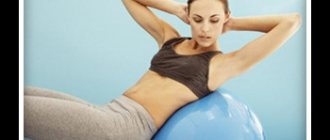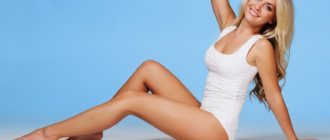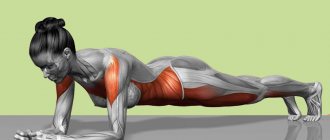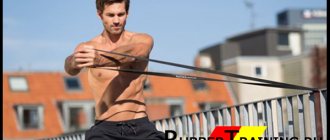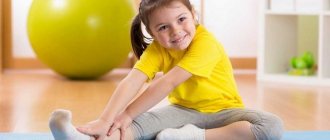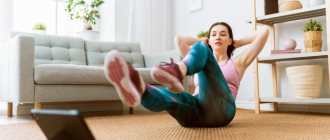Friends! I would like to present to you a series of four articles, which we decided to devote to such a popular exercise as squats.
And really, what could be simpler and more effective? Squats help pump up the muscles of the buttocks and hamstrings, as well as strengthen the quadriceps. Adding this type of exercise to your regular training program will not only provide a noticeable visual effect in the form of elastic, rounded shapes, but will also significantly reduce the likelihood of knee injuries.
Also, physical exercise in general (and squats in particular) is an excellent prevention of osteoporosis and other age-related diseases. We at just-fit.ru have selected for you 40 variations of various squats, belonging to four different categories of exercises:
- With its own weight (without additional equipment).
- Plyometric (explosive fast movements, jumping).
- With free weight (dumbbells or barbell).
- Using additional equipment (on simulators).
A separate publication is devoted to each type of squat. Now you can fully enjoy your workout!
Regular squats
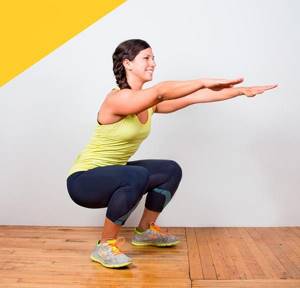
Stand straight, place your feet shoulder-width apart, feet parallel, and extend your arms forward, palms down. Look in front of you, keep your abdominal muscles tense. Without changing the position of your arms, bend your knees until your thighs are parallel to the floor. Squeeze your gluteal muscles as if you were sitting in a chair.
There is a popular belief that when performing squats, the knees should not extend forward beyond the toes. Don't worry too much about following this rule, because depending on the length of the limbs and the flexibility of the hip joints, the knees can still extend further and there is nothing wrong with that. As long as you don't experience pain, everything is fine. Return to the starting position.
Technique. From weightlifting to bodybuilding
The basics of exercise techniques where you need to pay particular attention to your back - deadlifts, squats - largely come from weightlifting. And in sports, technique is subordinated primarily to the main thing - effectiveness. And the strict requirement to keep the back rigid, maintaining lumbar lordosis, is due to the fact that this is the only way to ensure rigidity of the body and thereby give the barbell the necessary acceleration during the “undermining”. The acceleration should be such that the barbell is thrown up so that the athlete has time to perform the so-called. "slouched"
The forces from extension of the knee and hip joints should be immediately, completely, without shock absorption due to bending of the back, transferred to the barbell. Imagine that you need to sharply throw a weight hanging on the end of a rigid stick or flexible fishing rod. It is possible to do this only with a stick - the fishing rod, bending, absorbs shock. The stick is the spine, the rope is the arms, the weight is the barbell.
Another advantage of maintaining lumbar lordosis: the pelvis will not tilt backward and will provide a stable support for the contracting gluteal muscles.
Then squats and deadlifts migrated to bodybuilding, but recommendations on technique remained. It is no longer necessary to accelerate the barbell; you can lift it slowly, therefore, although in theory the need to keep a straight back was still declared, in practice they did not bother with this. Look at photos of legendary bodybuilders:
We tried, of course, to keep our back straight, but the main thing was the weight!
On one leg
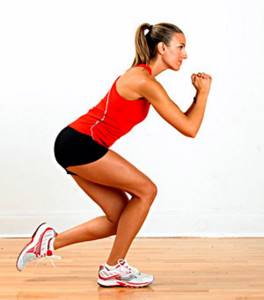
Perhaps you have noticed that one leg is slightly stronger than the other? This is typical for most people! Doing single leg squats can help correct this muscle imbalance. Get into the starting position for a regular squat. Now lift your left leg up, bending your knee slightly. You can move your leg forward or backward depending on which position you feel more stable in. Using only your right leg, lower yourself down as far as you can. Return to an upright position.
Try not to place your left foot on the floor between repetitions. If necessary, you can rest your hand on a chair or wall. Repeat the exercise on the other leg to balance the load.
Inventory

The exercise is sometimes performed in a Smith machine. Moreover, some believe that this is a safer option. But all safety here is limited to just one point - the athlete can put the barbell on the racks at any time. Otherwise, Smith creates an anatomically unnatural movement pattern, and “thanks to” him the athlete can be seriously injured. In addition, in Smith only a few can achieve the required gray depth.
It’s much easier to do the exercise with dumbbells, but this option will only be good for someone who wants to improve their deadlift rather than their squat, since the load will be placed very specifically on the muscles.
The exercise can be performed as a goblet squat style with a single kettlebell on the chest, or as a functional movement with a sandbag.
Smith machine squats with narrow legs
Gun
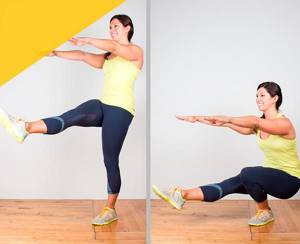
If you want to impress people at the gym or at a party, or just want to make the most of your legs, learn how to make a pistol. This exercise is not easy to master, but its results are truly impressive.
Stand up straight and extend your arms forward, palms down. Shift your body weight to your right leg, and lift your left leg straight in front of you parallel to the floor and arms. Slowly squat down on your right leg until your thighs touch your heels. At the lowest point, the left leg should be at a height of several centimeters from the floor. Congratulations – you have completed the easy part of the exercise!
Now your task is to stand back up, trying not to fall and not put your left leg on the floor. This exercise is only suitable for people who are in excellent physical shape. If you are just a beginner athlete, you can use this exercise for inspiration and do simpler versions. The pistol squat is really hard!
Benefits and disadvantages of exercise
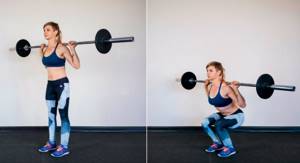
Developed quadriceps help prevent injuries associated with running, walking on slippery surfaces and playing sports. In addition, it is simply beautiful - the relief of the hips is an indicator of physical fitness. In recent years, the trend has changed, and even in women’s bodybuilding categories such as “wellness” and “body fitness”, developed quadriceps have become welcomed.
In strength sports, this squat variation helps lift more weight if the athlete is naturally endowed with a narrow pelvis and long legs. When the hip joint does not allow for a wide stance, which is considered more powerful, a narrow stance will be beneficial. In addition, it is in a narrow stance that snatches and clean and jerks for weightlifting are learned.
Pros of the exercise:
- develops the leg muscles as a whole, allowing you to place emphasis on the quadriceps;
- strengthens the long back muscle;
- helps make the latissimus muscles stronger due to static load;
- teaches proper knee work in all types of squats;
- allows you to quickly gain muscle mass;
- improves the shape of the buttocks;
- develops balance;
- increases the range of motion in the hip joint.
The downside of the exercise is that, like any other technical variations of the squat, it is not suitable for all athletes. Most people only have one optimal squat stance, and it is either narrow or wide. For such people, even as a special preparatory exercise, a “different” stance is not suitable.
The second negative point is that the exercise is often demonstrated in the wrong technique - with parallel feet. This version can only be performed by very flexible athletes who are not injured. For everyone else, this position can cause hip injury.
The main disadvantage of basic exercises is that a person must be well acquainted with the technique to perform them. It is not always possible to install it yourself and for most it is better to seek help from professionals for this.
✔SQUAT WITH NARROW LEGS.
Chair squats
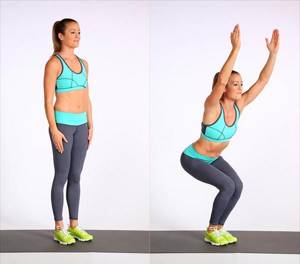
Just because this exercise is called a “chair” exercise does not mean that you can take a chair and happily sit on it. Stand up straight with your feet together. Sit down, pushing your pelvis back until your thighs are parallel to the floor, as if you were sitting down in a chair. Stretch your arms up for balance. Next, you can return to the starting position or complicate the task for yourself and stay in a “sitting” position for a few seconds.
Eagle pose

Those who think squats are too boring will be happy with this exercise. Stand up straight, put your feet together, and spread your arms to the sides. Now lift your right leg and wrap it around your left leg, placing your foot around the back of your left shin.
If you can't do this, simply place the thigh of your right leg on the thigh of your left. Now bring your arms in front of you so that your right elbow is under your left, and bend your elbows. Your forearms should be together. Now try to sit down. If you keep a good balance, then you can do it.
If someone looks at you and shamelessly makes fun of you, tell him that pretzels are your favorite food. Of course, if you can speak in this position. Well, if you didn’t understand anything written above and are confused in your own limbs, just look at this picture.
Four
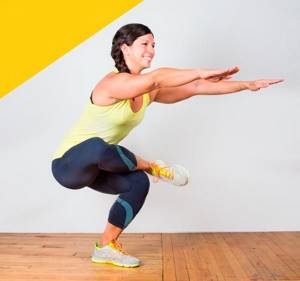
Can this exercise be called a squat? Or is it more of a stretch? Maybe a tie? It doesn’t sound like much... This exercise perfectly works the muscles of the supporting leg and at the same time serves to stretch the free leg.
Stand straight, feet together, knees slightly bent. Now lift your right leg up, bend it at the knee and place your ankle on the knee of your left leg. Slowly, so as not to lose your balance, squat on your left leg until your thighs are parallel to the floor. Try not to tilt your hips in one direction or another. Rise up slowly. Repeat on the other leg.
Buttocks to heels
Stand straight, bring your legs together, stretch your arms forward, palms down. Bend your knees and lower yourself down until your buttocks touch your heels. During this exercise, your heels will involuntarily lift off the ground, and your knees will move forward far beyond the level of your toes.
You are doing everything right! At the lowest point, lower your hands to the floor, slightly supporting yourself. Return to the starting position.
What muscles work

When performing an exercise with a barbell, almost all the muscles of the body are included - the latissimus dorsi, rhomboids, muscles of the legs, buttocks, arms and core as stabilizers. Therefore, the movement is basic and is often used to gain weight.
Muscles that are the basis of movement:
- hamstrings and quadriceps;
- gastrocnemius and soleus;
- the entire array of gluteal muscles
Squat crunch
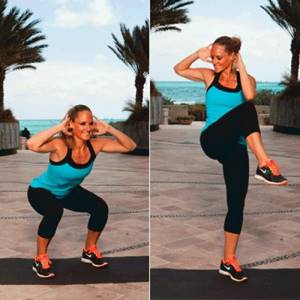
Place your feet shoulder-width apart. Do a regular squat. As you come out of the squat, lift your right knee and, twisting your body, reach your left elbow with your knee. Repeat on the other leg.
So, here you have a complete and varied lower body workout consisting of just squats. By doing these exercises regularly, you will achieve truly amazing results!



